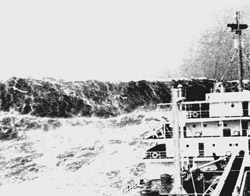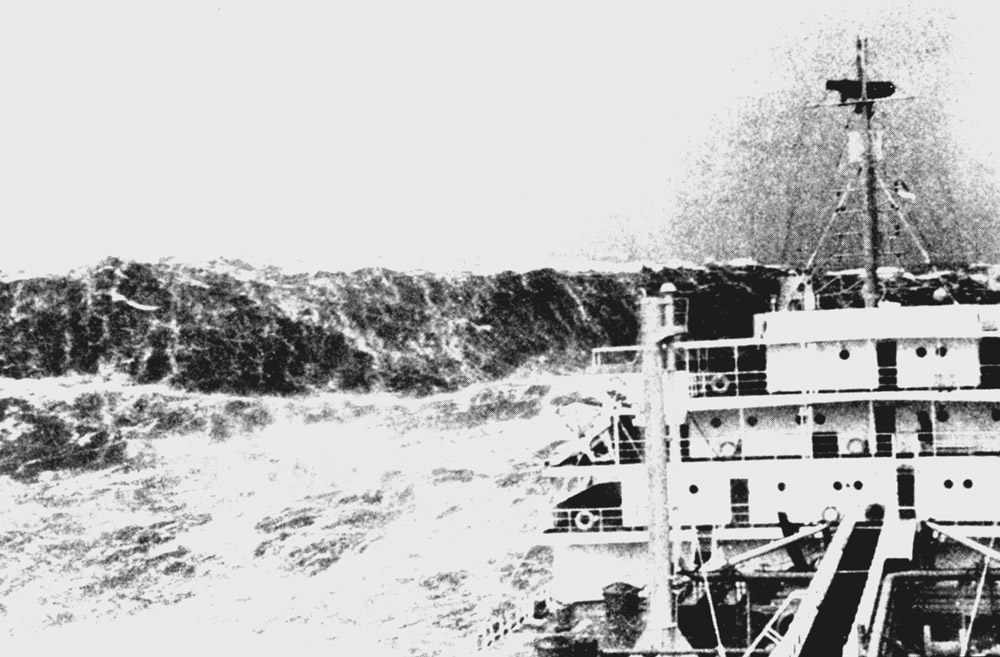Waves of Destruction
The movie Poseidon features a giant wave that comes out of nowhere to flip a star-packed ocean liner. Such freakishly tall waves in the middle of the ocean are no longer considered fictional, thanks in part to recent satellite observations and computer simulations. In the 1 September PRL, a team describes a new simulation where two wave trains meet at an angle. They observed so-called rogue waves appearing more rapidly and looking more realistic than in other simulations. Researchers in the field hope that better understanding of the causes of such waves will lead to improved ship designs and better forecasts of wave conditions.
Many otherwise unexplainable ship sinkings have been attributed to rogue waves, which are single, sharply-peaked mounds of water that rise out of the ocean. Measurements by offshore oil platforms and satellites put the waves at heights up to 30 meters, but most ships are built to withstand just 15-meter waves. Despite the need, researchers still don’t understand exactly how rogue waves form.
To make a rogue wave, you need to combine the energy of several ordinary waves. This is unlikely to happen by mere chance, so theorists have devised several ways to focus ocean waves into one spot. One way is to have an ocean current oppose the direction of wind-swept waves, causing a traffic jam out of which a giant could arise. But rogues often occur without significant currents, so one popular alternative is to assume a so-called non-linear property of the waves, in which the wave velocity depends on the wave height. In a group of waves, smaller ones travel slower and can pile up on a faster-moving large wave if it comes from behind. The small additions make the large wave still larger, and therefore able to speed up and “swallow” even more small waves. “Because of this positive feedback, the energy is self-focused,” explains Mattias Marklund of Umea University in Sweden.
Previous theoretical calculations and wave tank experiments have shown that this self-focusing can occur in a system of waves of various wavelengths all traveling in the same direction. However, many ship accidents occur in crossing seas, where one wave train meets another coming from a different direction. “It is a quite common condition on the ocean,” says Miguel Onorato of the University of Torino in Italy. Earlier this year, Onorato and his colleagues analyzed non-linear focusing in such two-wave systems [1]. They solved the wave equations mathematically in some special cases but did not perform any simulations.
Expanding on these results, Marklund and his colleagues have now shown that two-wave systems can exhibit runaway growth that is three times faster than in single wave systems. “The two systems can help each other focus the energy,” Marklund says. The researchers confirmed mathematically that this enhanced focusing happens predominantly when the angle between the two wave systems is less than 70 degrees. This type of information could help forecasters pinpoint ocean areas more susceptible to rogues.
In simulations, Marklund’s team found that when two wave systems–each with average wave height of 3 meters–meet at an angle of 45 degrees, 10-meter-high waves appear in about ten minutes. “These simulated freak waves have a striking resemblance to satellite images of real freak waves,” Marklund says, in part because they are localized in two dimensions, rather than stretching like a long stripe across the water, as in other simulations. Onorato says it is probably too soon to say whether these results are realistic, since observational data is still very limited. “But this is a good starting point,” he says.
–Michael Schirber
Michael Schirber is a Corresponding Editor for Physics Magazine based in Lyon, France.
References
- M. Onorato, A. R. Osborne, and M. Serio, “Modulational Instability In Crossing Sea States: A possible Mechanism For The Formation Of Freak Waves,” Phys. Rev. Lett. 96, 014503 (2006)
More Information
basic rogue wave physics from the University of Oslodetecting rogue waves from satellites from the European Space Agency





